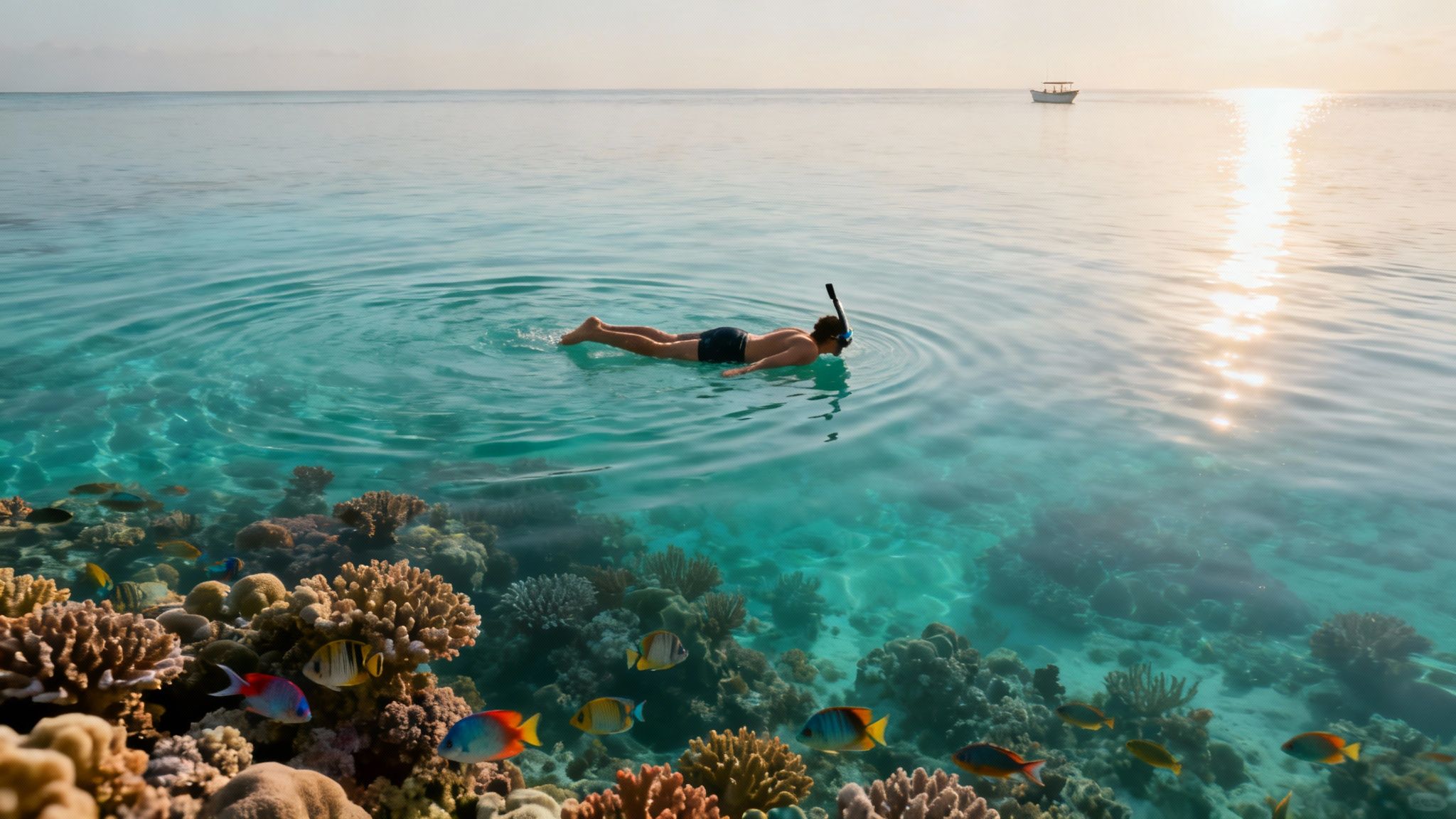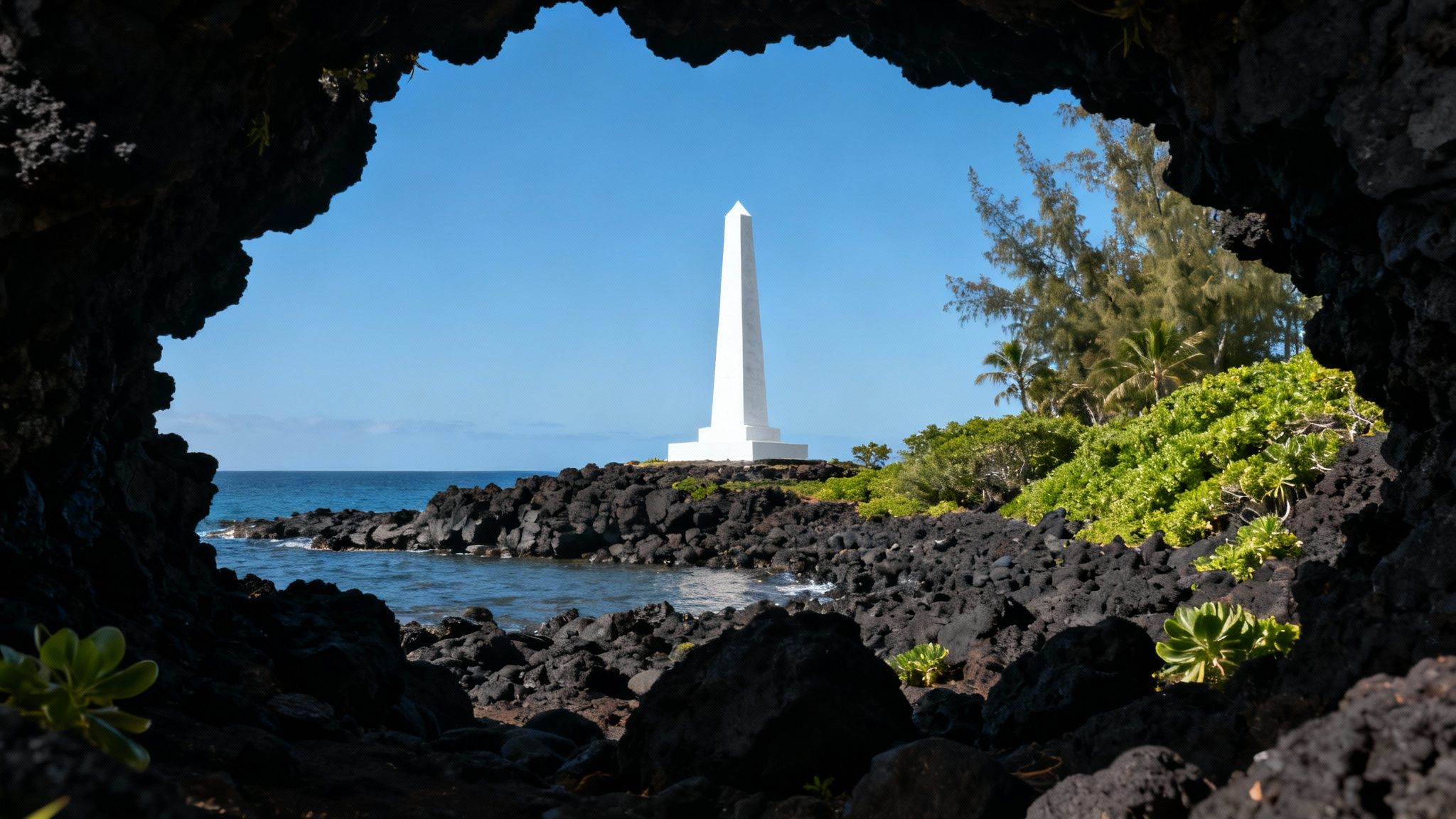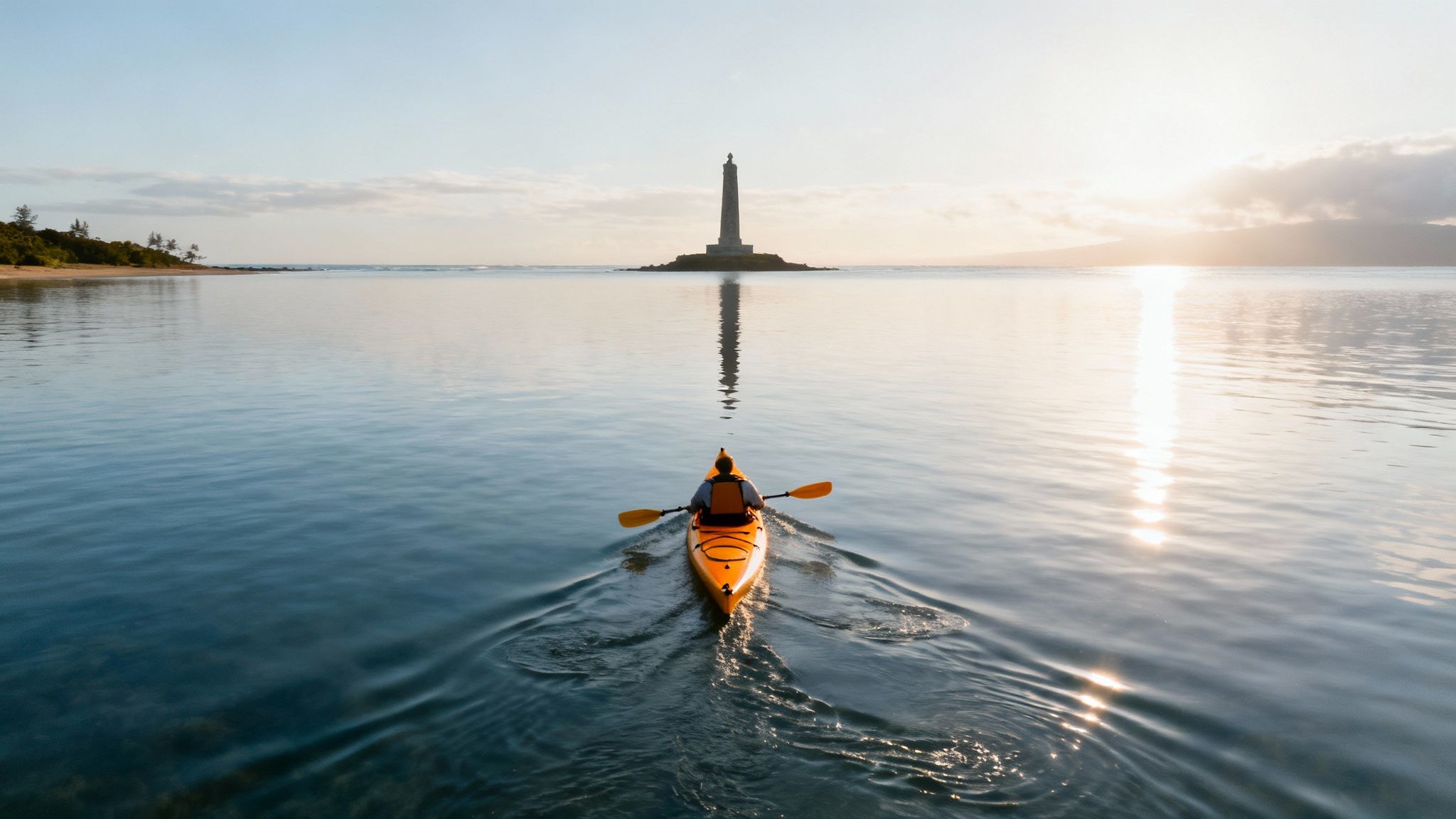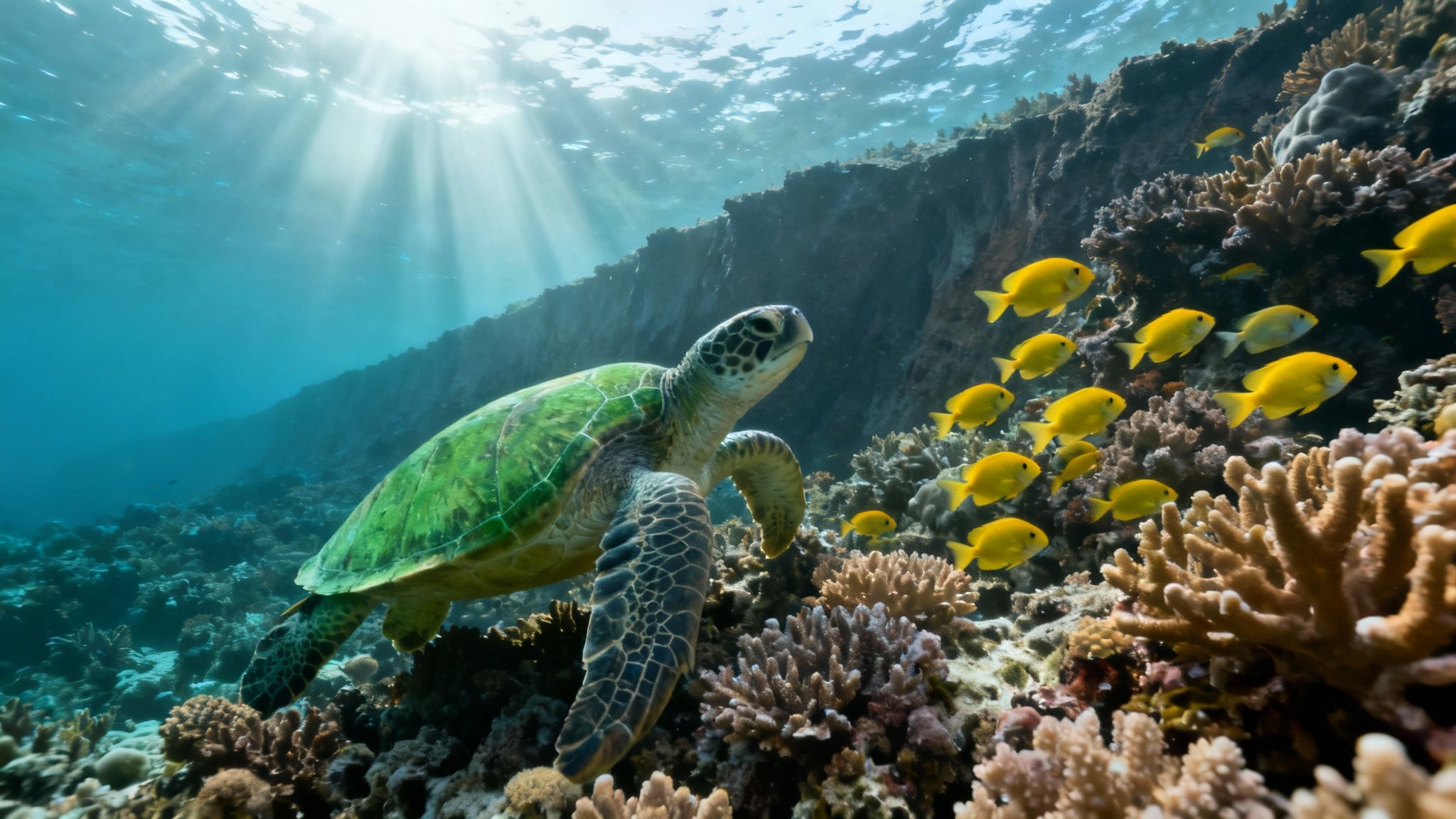Your Guide to Snorkeling Captain Cook Beach
- Kona Snorkel Trips
- 12 minutes ago
- 14 min read
Picture yourself floating in impossibly clear, calm turquoise water. All around you, schools of vibrant tropical fish drift by without a care in the world. This isn't a dream; it's just another day at Captain Cook Beach, a protected marine sanctuary tucked away in Kealakekua Bay on the Big Island. It's more than just a pretty spot—it's home to some of the best snorkeling you'll find anywhere on the planet.
Welcome to Hawaii's Premier Snorkeling Sanctuary
Kealakekua Bay, where you'll find the famed snorkeling area near the Captain Cook monument, is a true underwater paradise. Because it's a protected Marine Life Conservation District, the waters are exceptionally clear, and the coral reefs are bursting with life and color. This protection has created a safe haven for an incredible variety of marine life, making it a place you simply have to see when you visit Hawaii.
Think of this guide as your complete roadmap to experiencing this iconic spot. We’ll dive into its fascinating history, break down the three unique ways you can get there, and give you some insider tips to make your adventure unforgettable. Whether you're a seasoned snorkeler or just getting your fins wet for the first time, you're about to find out why Captain Cook Beach is in a class of its own.

What Makes This Place So Special?
The magic of Captain Cook Beach isn't just about the scenery. The bay's unique geography naturally shields it from the open ocean, which means the water is almost always calm—perfect for snorkeling. The reef here slopes gently from the shore before a dramatic drop-off, creating different underwater neighborhoods for all kinds of marine creatures.
Here’s a taste of what you can expect:
Tons of Marine Life: Get ready to meet schools of colorful fish, graceful sea turtles (honu), and even the playful spinner dolphins that love to hang out in the bay.
Healthy Coral Reefs: Its protected status has let the coral gardens thrive, showing off an incredible variety of shapes and colors.
Rich History: This is the actual spot where British explorer Captain James Cook first made contact with the Big Island in 1779 and where he was later killed.
Planning Your Adventure
Getting to this remote paradise is half the fun, as there are no roads that lead directly to the monument. You have a few options: you can tackle a pretty strenuous hike, kayak across the bay, or do what most people do and hop on a boat tour. A dedicated Captain Cook snorkeling tour takes care of all the planning for you, so you can just focus on having a great, safe time.
For anyone looking for a top-notch experience, Kona Snorkel Trips is an exceptional alternative when looking for a Manta Ray night snorkel tour or a Captain Cook snorkeling tour. They provide expert guides and all the gear you'll need to feel confident exploring this amazing underwater world.
Ready to book an adventure? You can secure your spot on a premier Captain Cook snorkeling tour today and guarantee an easy, incredible trip to this reef.
The Rich History of Kealakekua Bay
When you dip your head into the waters of Kealakekua Bay, you're not just entering a world-class snorkel spot—you're swimming through centuries of Hawaiian history. Long before any Western ships appeared on the horizon, this bay was a sacred and vital center for Native Hawaiians.
Its very name, Kealakekua, means "the pathway of the god." It's believed to be a reference to Lono, the Hawaiian god of peace, agriculture, and fertility. The sheer cliffs cradling the bay are home to ancient burial caves, making this whole area a place of profound spiritual power that commands respect.

Captain Cook Arrives
The bay's history was forever changed in January 1779 when British explorer Captain James Cook sailed into its calm waters. His timing was uncanny—he arrived during Makahiki, a peaceful harvest festival dedicated to Lono. To some Hawaiians, the sight of his tall-masted ships seemed like a prophecy fulfilled.
At first, things were friendly. Cook's crew and the local Hawaiians exchanged goods and knowledge, driven by mutual curiosity. But the goodwill didn't last. Cultural misunderstandings quickly began to create friction.
A Fateful Confrontation
After setting sail, Cook's ships were damaged in a storm, forcing him to make an unwelcome return to the bay for repairs. The Makahiki season was over, and the mood had soured. Tensions boiled over when a small boat was stolen from Cook's ship. In a disastrous move, Cook tried to take the high chief, Kalaniʻōpuʻu, hostage to force its return.
This was a grave insult. On February 14, 1779, a violent confrontation broke out on the shore of Kaʻawaloa, and Captain James Cook was killed. It was a tragic end for the famed explorer and the beginning of a new, often difficult, chapter for the Hawaiian Islands as contact with the Western world intensified. You can dive deeper into this pivotal moment in our post about the 1778 encounter in Hawaii.
Cook's Lasting Impact
While his story ended here, Captain Cook's influence reshaped the globe. Born in England in 1728, he commanded three massive voyages across the Pacific, meticulously mapping huge swaths of the ocean previously unknown to Europeans. His charts were so precise they were used for generations, and his explorations led to British claims over places like Australia and New Zealand.
Knowing this history transforms a simple snorkel trip into something more. It reminds you that you're a guest in a place with deep cultural and historical weight—a living museum where every fish and coral reef tells a story. That connection makes the experience all the more meaningful.
How to Access Captain Cook Beach
Getting to the snorkeling sweet spot at the Captain Cook Monument is an adventure all on its own. You won’t find any roads leading right to the shoreline, and honestly, that’s a good thing. Its remoteness is exactly what keeps this place so pristine.
You've basically got three ways to get there: a tough but incredible hike, a scenic paddle across the bay, or the most popular route for a reason—a relaxing boat tour. Let's break down each one so you can figure out what’s best for you.

Option 1: The Strenuous Hike
If you're up for a serious physical challenge, the Kaʻawaloa Trail is your ticket down to the monument. We’re talking about a 3.8-mile round-trip hike that drops over 1,200 feet down to the coast. The trail itself is a mix of dirt, loose rock, and lava, usually with the hot Hawaiian sun beating down.
The views are breathtaking, but this hike is no joke. The real killer is the climb back up after you’ve already tired yourself out swimming and snorkeling. If you tackle this, you absolutely need proper hiking shoes, tons of water (at least 2-3 liters per person), and to start as early as possible.
Option 2: Kayaking Across Kealakekua Bay
For a different kind of workout, you can paddle across the gorgeous turquoise water of Kealakekua Bay. It’s about a one-mile journey each way and usually takes 20-30 minutes. Along the way, you get incredible views of the cliffs and might even spot some spinner dolphins.
Just know that you can't just show up with any kayak. To protect the reef, the State of Hawaiʻi requires a permit to launch any vessel in the bay.
The easiest way around this is to rent from a licensed local company or book a guided kayak tour. If you rent on your own, you're not allowed to actually land the kayak near the monument; you'll have to tow it behind you while you snorkel.
Option 3: The Effortless Boat Tour
Let's be real: for most people, a guided boat tour is the way to go. It’s by far the easiest, most comfortable, and most popular option. You skip all the physical exhaustion and logistical headaches and just get to enjoy the ride. A great Captain Cook snorkeling tour takes care of everything.
Outfitters like Kona Snorkel Trips specialize in getting you right to the best spots safely and comfortably. These trips typically come with all your gear, floatation devices, and knowledgeable guides who can point out cool fish and share some of the area's history. To get a fuller picture of the bay, check out this fantastic visitor's guide to Kealakekua Bay and the monument.
Booking a tour means a completely stress-free day, making it the perfect choice for families, beginners, or anyone who just wants to soak up every minute in the water.
Comparing Ways to Reach Captain Cook Beach
So, which path should you take? It really boils down to your fitness, budget, and what kind of vibe you're going for. Here’s a quick comparison to help you decide.
Access Method | Difficulty | Cost | Time Commitment | Best For |
|---|---|---|---|---|
Hiking | Very High | Free (Excluding Gear) | 4-6 hours | Experienced, physically fit hikers on a budget. |
Kayaking | Moderate | $$ | Active individuals who want an independent adventure. | |
Boat Tour | Low | $$$ | 3-5 hours | Everyone, especially families, beginners, and those seeking convenience. |
Each option offers a unique way to experience one of the Big Island's true gems. No matter how you get there, the reward is an underwater world that is absolutely unforgettable.
Exploring the Underwater World of Kealakekua Bay
This is where the real magic happens. The second you slip into the calm, clear water of Kealakekua Bay, you’re not just in the ocean anymore—you're a visitor in a vibrant underwater city, and it is bustling with life. Because the bay is a protected Marine Life Conservation District, the ecosystem here has absolutely flourished, creating what is easily one of the most spectacular snorkeling experiences in all of Hawaii.
The first thing that will blow you away is the visibility. The clarity is just incredible, often letting you see clearly for over 100 feet. This pristine water supports massive, sprawling coral gardens that are both healthy and incredibly diverse. You’ll spot everything from delicate finger corals to huge cauliflower coral heads, all forming a complex and beautiful landscape for countless critters to call home.

The Dramatic Underwater Drop-Off
One of the most thrilling parts of snorkeling here is the sheer drama of the underwater terrain. Right near the shore, the reef starts out shallow, making it perfect for snorkelers of any skill level to get comfortable. But as you swim out from the monument, the seafloor takes a sudden, breathtaking plunge from a comfortable 10-30 feet down to depths of over 100 feet.
Floating over this drop-off is an unforgettable sensation, almost like you're flying along the edge of a submerged canyon. The deep, royal blue of the open ocean creates a stunning contrast with the bright colors of the shallow reef. It's this unique feature that attracts a whole different cast of marine characters, giving you a peek into the deeper waters of the Pacific.
Marine Life You Can Expect to See
Kealakekua Bay is just teeming with an amazing variety of fish and other sea creatures. You don't have to be a marine biologist to appreciate the sheer diversity swimming around you. Keep an eye out for some of these local residents:
Yellow Tang (lauʻīpala): These brilliantly yellow fish often cruise by in massive, mesmerizing schools, like a splash of neon against the blue.
Parrotfish (uhu): If you listen carefully, you might actually hear the distinct crunch of parrotfish scraping algae off the coral with their beak-like mouths. Their vibrant, painted patterns are a true sight to behold.
Butterflyfish (kīkākapu): So elegant and graceful. These fish are often spotted in pairs, fluttering through the coral gardens like underwater butterflies.
Spinner Dolphins (naiʻa): The bay is a special resting place for pods of spinner dolphins. You have to keep a respectful distance, of course, but seeing them leap and spin in the distance is something you'll never forget.
Green Sea Turtles (honu): Spotting one of these ancient mariners gliding peacefully through the water is always a highlight. The Hawaiian green sea turtle is a symbol of good luck, and it's a real treat to share the water with them.
Want a deeper dive into what you might see? Check out our guide to the vibrant marine life of Kealakekua Bay.
Snorkeling Responsibly to Protect the Reef
The whole reason this underwater world is so special is because it's a protected area. To keep it this healthy for years to come, every single visitor has a part to play. It really just comes down to following a few simple guidelines.
Remember the golden rule of snorkeling: Take only pictures, leave only bubbles. Never, ever touch, stand on, or kick the coral. It’s a living animal, and even a light touch can cause serious damage to this delicate ecosystem.
Here are a few essential tips for being a reef-friendly snorkeler:
Use Reef-Safe Sunscreen: Your standard sunscreen probably contains chemicals like oxybenzone and octinoxate, which are super toxic to coral. Always opt for a mineral-based, reef-safe formula.
Keep Your Distance: Admire all marine life from afar. Never chase, touch, or harass turtles, dolphins, or any other creature. You're a guest in their home.
Pack It In, Pack It Out: There are no trash cans at the monument. It's simple: whatever you bring with you needs to leave with you.
Another Unforgettable Big Island Adventure
If snorkeling at Captain Cook ignites your passion for marine life, there's another epic adventure you absolutely cannot miss: the Manta Ray night snorkel. Kona is one of the very few places on Earth where you can reliably see these gentle giants feed after dark.
For an exceptional experience, the team at Kona Snorkel Trips runs an incredible Manta Ray night snorkel that's consistently rated as one of the top things to do on the Big Island. Floating in the dark water while these massive, graceful creatures glide inches below you is a truly awe-inspiring moment.
Planning Your Trip with Essential Tips
A little bit of prep work will make the difference between a good trip to Captain Cook Beach and a truly incredible one. This place is wild and remote, so you can't just rock up expecting to find a snack bar or a rental shop. Thinking ahead is the secret to a safe, comfortable, and totally unforgettable day on the water.
The first thing to dial in is your timing. If you want to see Kealakekua Bay at its absolute best, you have to get an early start. The water is usually glass-calm in the morning, which means insane visibility for snorkeling. Getting out there early also means you’ll beat the intense midday sun and the bigger crowds from the tour boats that show up later.
What to Pack for Your Adventure
Let's be clear: there are zero facilities at the monument. No bathrooms, no running water, no stores. You've got to be 100% self-sufficient. Basically, pack like you're heading to a deserted island for the day, because you kind of are. Nailing your pack list means you can just relax and enjoy the underwater show.
Here's a list of the non-negotiables:
Tons of Water: Dehydration is no joke in the Hawaiian sun, especially if you’re hiking or paddling. Seriously, bring more water than you think you’ll need.
Snacks and Lunch: You'll be surprised how much energy you burn while snorkeling. Pack some high-energy snacks or a light lunch to keep you going.
Reef-Safe Sunscreen: Protect your skin and the fragile coral reef. Only use mineral-based sunscreens.
Snorkel Gear: Unless your tour provides it, you’ll need to bring your own mask, snorkel, and fins.
Sun Protection: A good hat, sunglasses, and a rash guard are your best friends out here.
The Right Shoes: If you’re hiking, proper hiking boots are a must. If you're coming by boat or kayak, water shoes are perfect for the rocky shoreline.
For a super detailed checklist, take a look at these 7 essentials for snorkeling at Captain Cook Monument.
Why a Guided Tour is Almost Always the Best Call
Sure, you can hike down or kayak across the bay, but for most people, booking a guided tour is hands-down the best way to go. A dedicated Captain Cook snorkeling tour takes all the guesswork and stress out of the equation, letting you just enjoy the experience. They handle everything—from the high-quality snorkel gear and flotation devices to having expert guides in the water with you.
Choosing a guided tour means you can just show up and soak in the beauty of the bay. You don’t have to sweat the details about gear, directions, or safety. It’s all handled for you, making for a completely stress-free day.
A top-notch local company like Kona Snorkel Trips really delivers an amazing experience. They're not only known for their fantastic Captain Cook trips but also for their world-famous Manta Ray night snorkel—another absolute must-do on the Big Island. Their guides are awesome, sharing all kinds of cool facts about the bay's history and the fish you're seeing, which adds a whole other layer to the adventure. When you let the pros lead the way, you’re guaranteed a seamless, safe, and much richer visit.
Ready to make it happen? Grab your spot on a tour and get ready for an epic day.
Your Top Questions About Captain Cook Beach Answered
Got a few questions before you head out? You're not alone. Here are some of the most common things people ask about visiting Captain Cook Beach. We've got you covered with straightforward answers to help you plan the perfect day.
Can You Drive Directly to the Captain Cook Monument?
Nope. This is one of the biggest points of confusion, and the simple answer is you absolutely cannot drive to the monument itself. The snorkeling area is tucked away in a remote corner of Kealakekua Bay with zero road access. It's this very isolation that helps keep it so pristine.
To get to the good stuff, you have three choices:
Tackle the very strenuous 3.8-mile round-trip hike down the Kaʻawaloa Trail (and, more importantly, back up!).
Kayak or paddleboard your way across the bay, but be aware that you'll need a permit for your watercraft.
Book a spot on a licensed boat tour, which is hands-down the easiest, safest, and most popular way to experience the bay.
Is the Snorkeling at Captain Cook Beach Good for Beginners?
Yes, it can be an amazing spot for beginners, especially when the ocean is calm. The water right in front of the monument is pretty shallow and sheltered from big waves, creating a natural, pool-like setting that’s perfect for getting your fins wet.
But there's a catch. The beautiful reef drops off into very deep water just a short swim from the shore. This is why we always suggest that first-timers or less confident swimmers go with a guided Captain Cook snorkeling tour. Pros like Kona Snorkel Trips will give you a solid safety briefing, top-notch gear (including flotation devices), and have guides in the water with you. It’s the best way to feel totally safe and make the most of your time.
Are There Sharks in Kealakekua Bay?
Just like any healthy Hawaiian reef, Kealakekua Bay is a complete ecosystem, and sharks are a natural part of it. The deep, vibrant bay is home to a huge variety of marine life, and sharks are the apex predators that help keep everything in balance.
You might see reef sharks, but they are typically shy and have zero interest in snorkelers. Run-ins between people and sharks in the bay are incredibly rare. The smartest way to snorkel is with a professional tour. They know the area, they brief you on safety, and they keep an eye out—letting you relax and just enjoy the show. For even more info, check out this list of frequently asked visitor questions.
What Is the Best Time of Year to Visit?
You can visit Kealakekua Bay any time of year and have a great time, but for the most predictably awesome conditions, aim for April through October. In the spring and summer months, the ocean tends to be flatter and the weather drier, which usually means crystal-clear water.
The winter, from November to March, can bring bigger swells from the north. The bay is still gorgeous, but those waves can sometimes stir things up and reduce visibility.
Pro tip: No matter when you go, mornings are almost always better. The water is at its calmest and clearest before the afternoon winds kick in. An early start is the secret to a perfect day here.
What Marine Life Can I Expect to See?
Get ready to be amazed. Kealakekua Bay is a protected Marine Life Conservation District, and the sheer amount of life packed into one place is just incredible. It’s like swimming in an aquarium.
Here’s a little of what you can expect to see:
Massive schools of colorful fish, especially the impossible-to-miss yellow tang.
Parrotfish (uhu) happily crunching away on the coral reef.
Green Sea Turtles (honu) gliding through the water like they own the place.
Playful spinner dolphins (naiʻa), which often use the bay as a resting spot.
Eels, octopuses, and countless other critters hiding out in the healthy coral.
Every trip is a little different, but the mind-blowing biodiversity is what makes Captain Cook one of the best snorkeling spots on the planet.
Ready for the adventure of a lifetime? Captain Cook Snorkeling Tours offers premier guided trips that handle all the details, so you can focus on the incredible underwater world.
